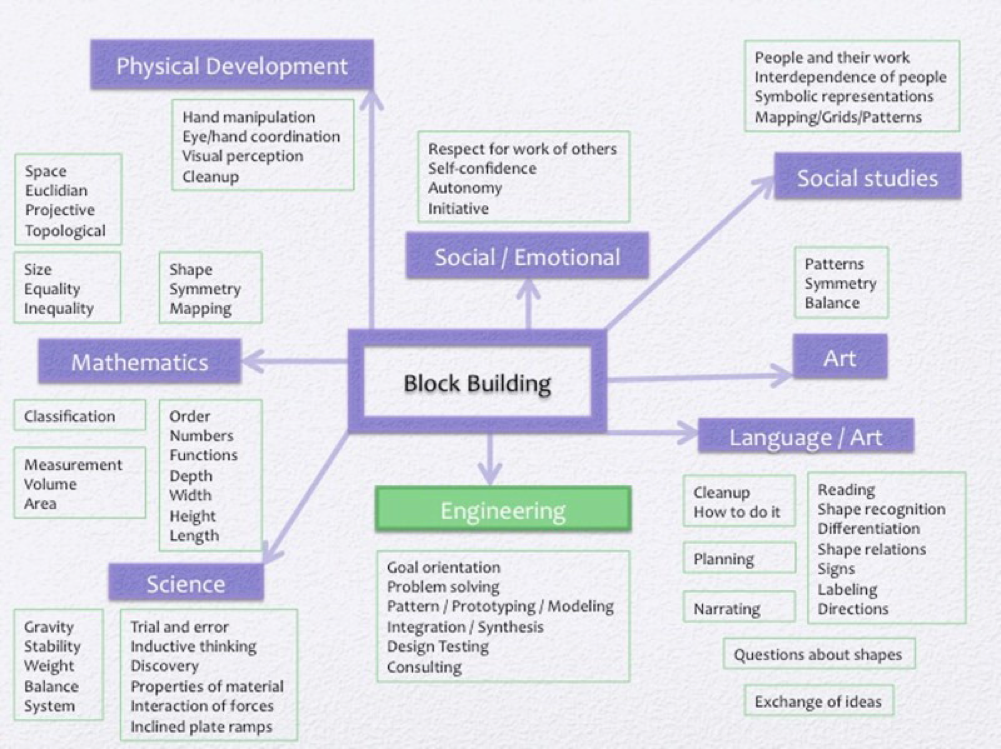Let's Build: How Playing With Blocks Benefits Children
This resource was created as a supplement for the Language Builder: Academic Readiness Intervention System (ARIS) complete early autism curriculum, Lesson #63, Block Imitation - Basic Structures. Download a free copy of the lesson and learn more about the ARIS curriculum.
It’s no surprise that colorful building blocks are a staple in early childhood centers, given the robust research that supports benefits gained from playing with blocks. Besides the simple joy in building and creating, playing with blocks improves literacy and storytelling skills, builds engineering and mathematical concepts, and teaches young children about communication and collaboration.
Telling Stories With Blocks
Because the block shapes do not represent a specific object, children have the freedom to create structures, settings, and stories from the blocks. The blocks serve as a starting point for building stories. Children can also create scenes to reenact their favorite settings in picture books or other stories. Early childhood researcher Janie Heisner has found that incorporating blocks and other toys into the storytelling experience can help teachers and parents model story themes during playtime.
Furthermore, parents can ask their children questions about what they are building, what they plan to build, and the shapes and colors they are using. Or, parents can give or receive directions on how to build something. This promotes an exchange of ideas, which happens organically as kids are playing. Even after children outgrow playing with blocks, they continue to develop their imaginary play with their peers, a skill that starts with block play.
Building a Foundation for Math and Engineering Achievement
Though blocks may appear to be simple toys, research by Bagiatti & Evangelou (2016) and others has shown that block play during the preschool years has correlations with improvements in geometric, spatial, and arithmetic skills. That may be because blocks allow toddlers to begin by making very simple structures and advance to complex structures as they grow older. Time spent with blocks can reinforce concepts like symmetry, patterns, and shape names, which are taught at home and at school. During play, adults can guide children in either teaching concepts about color or shape, or in reviewing math concepts through asking children questions about their buildings. Constructing with blocks also previews more complex skills like understanding part-whole relationships, classification of shapes, and shape congruence.
Beyond academic benefits, block play speaks to a very human instinct to make structures that kids see in their daily lives. It gives young children a hands-on context to apply math skills. Abstract concepts like balance and gravity are experienced through toys, a playful tool for learning physics. Meanwhile, as kids figure out how one shape fits with another, or how one shape can stack on top of another, they learn spatial reasoning skills creatively, even before they have all the vocabulary to explain what is happening. Of course, much of this will happen through trial and error, but the process of discovery keeps kids engaged and builds the foundation for scientific thinking.
Learning about Collaboration and Communication
When playing with blocks as a group, children benefit from peer interactions that are important for development. As children work together to build designs, they are learning how to problem solve together. Naturally, they communicate through discussion any challenges that come up with eachother, the first steps in learning about collaboration. In playing together, children find ways to articulate the goals of what they are building and the rules of how they are playing together. Even if (and perhaps when) conflict arises, kids will learn about sharing and negotiation.
Collaborative building also stretches the imagination. Together, children often build more complex structures than the ones created alone. That means that the children have to explain what their building blocks represent. In other words, they are practicing play acting to achieve goals that they agree on. When they achieve success and are excited by what they have built, this is an opportunity for kids to build self-confidence and pride in their creations. Similarly, they also have a chance to learn how to respect their peers’ work and share in their success.
Finally, children get a chance to practice verbalizing spatial and mathematical skills when they talk to their peers or adults. They can practice numbers (“I need three blocks”), shapes (“A triangle goes on top”) or spatial reasoning (“The triangle is upside down”). Building vocabulary while manipulating blocks helps connect words to the object, and helps teach the child how to communicate their ideas.
Given all of these benefits, whether you are a parent or a teacher, enjoy watching your children play with blocks, or better yet, join in on the fun!
To find out more about research on block building and children’s development see:
Aikaterini Bagiati & Demetra Evangelou (2016). Practicing engineering while building with blocks: identifying engineering thinking, European Early Childhood Education Research Journal, 24:1, 67-85, DOI: 10.1080/1350293X.2015.1120521
This resource was created as a supplement for the Language Builder: Academic Readiness Intervention System (ARIS) complete early autism curriculum, Lesson #63, Block Imitation - Basic Structures. Download a free copy of the lesson and learn more about the ARIS curriculum.
The Language Builder: Blocks Set comes with a free iPad app you can download to turn block imitation into a fun game. You can download the app here.






